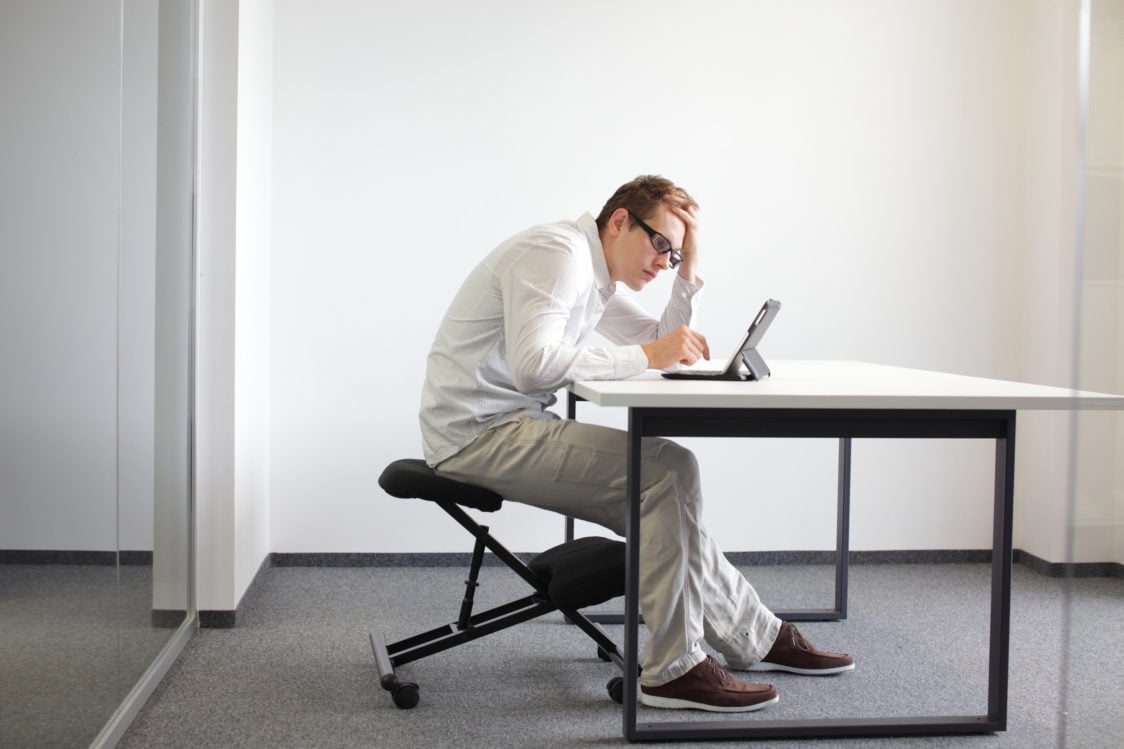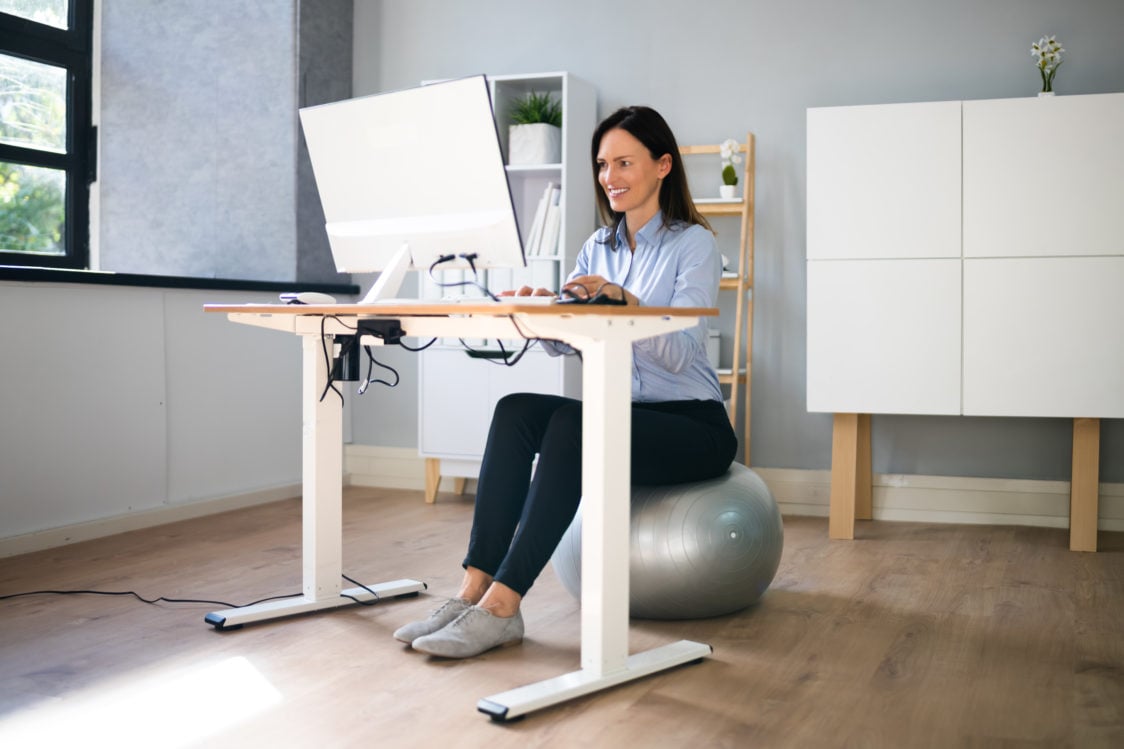Table of Contents
Back pain between the shoulder blades or in the lumbar spine is something almost everyone encounters in their lifetime. If you’ve experienced it before, you’ll surely confirm that it can make every move and daily chores very uncomfortable. It is therefore important to know the most common causes of these problems and look for ways to prevent them. Often it’s not difficult at all and you just need to make small changes in your posture, movement and overall lifestyle.
The 10 most common causes of back pain and their management
Back pain typically occurs in the thoracic and lumbar spine. However, you may have experienced similar problems a little higher up, in the cervical spine. What’s actually behind the back pain? There are a number of causes that can trigger these problems.
Often, however, lifestyle is to blame. In modern society, lack of exercise, poor posture when sitting at a computer, high levels of stress and other factors that are detrimental to the back are common.
1. Poor posture
Posture when standing, sitting or exercising has a big impact on back health. If you’re more likely to lie across a table or sit in positions that are more suited to a yoga class, it’s not exactly ideal for your back. You are not a robot, so it’s normal not to be able to sit in one position for hours. But remember that you should stick to at least the basic rules of correct posture. You may gradually get rid of pain in your lower back, hips or other parts of your back as a result. [1-2]

How to achieve the correct posture when standing?
- Stay upright. Imagine that a rope is passing through your body and someone is pulling it up.
- Try to keep your ears, shoulders, hips, knees and ankles aligned.
- Pull the shoulders and shoulder blades slightly back and down.
- Allow your arms to hang loosely by your side.
- Bend your knees slightly.
- Place your feet hip-width apart.
- Spread your weight evenly over your feet.
How to achieve the right posture when sitting and working at the computer?
- Do not bend or tilt your head.
- Try to keep your ears, shoulders and hips aligned.
- Try not to arch your back.
- Focus on maintaining the natural curve of the back (neutral position).
- The monitor should be at your eye level.
- Pull the shoulders and shoulder blades slightly back and down.
- Bend your elbows to an angle of approximately 90°.
- Keep your thighs and knees flat or slightly below hip level.
- Keep your feet flat on the ground.
- Take active breaks. Take a walk or do some light stretching.
Some factors, such as the type of chair or the height of the desk, may be beyond your control. If you’re not planning to buy new furniture, at least try to focus on other sitting posture rules that you can try immediately. In case you have a large Fit Ball, you can use it instead of a chair for a while. By constantly balancing on it, you’ll engage more of the muscles involved in maintaining an upright posture. However, it is definitely not advisable to sit on it for hours.
For more tips to help you get rid of back pain from improper sitting, check out our article 7 Tips to Beat Back Pain Due to Sitting for Long Periods of Time.

2. Lack of exercise
Endless hours spent sitting at a desk, driving in a car or watching a TV show from a comfortable couch is definitely not good for your back and overall health. It can cause back pain in your lower or thoracic spine. That’s why it’s important to compensate your downtime with sport and exercise. This is the only way to prevent weakening of the muscles, deterioration of their function and other negative changes that can manifest themselves in stiffness and pain in the back. If you are still looking for a cure for back pain, proper exercise may be the answer. [3]
How to exercise for a healthy back?
- Almost any kind of sport is good for the back, as long as it is done correctly. So choose an activity that you will enjoy in the long term.
- Engage in your chosen activity (walking, running, weight training) for a minimum of 150 minutes per week. For higher intensity activities (HIIT) a minimum of 75 minutes is sufficient.
- Strengthen the muscles of your whole body at least two times a week.
- Stretch and do exercises to relax the entire length of your spine.
- Focus on strengthening the back muscles and the deep stabilising system of the spine, which you may know as the centre of the body, the core. This helps with proper posture.
You can also find effective exercises to relax your back in our article 20 Exercises to Help with Back Pain.
You might be interested in these products:
3. Overload or injury during sport
You may have experienced this yourself. You’re doing great during exercise and you feel like you can do more, so you add more weight and despite all the euphoria you forget to watch your technique. At some point, this can result in a painful injury that takes you out of the game for days or weeks. Back injuries can also happen when you move suddenly, for example when a teammate passes you the ball unexpectedly during a basketball game. However, back pain can occur after a long period of time, for example, because of long-term improper technique when running or exercising. [4]
When to see a doctor for back pain caused by sport?
If you feel sharp pain in your back that increases and does not go away even when you rest, consider seeing a doctor. The same applies if the injured area is swollen, red, the muscle is unnaturally contracted and a fever has set in. If the injury prevents you from doing daily activities, be sure to see a doctor. [5]
How to prevent back injuries during exercise?
- Always warm up and stretch before a workout.
- Correct technique is always the first priority when exercising. Only then comes the choice of the load or the speed of the exercise.
- You can use an exercise belt during weight training, for example, for heavy squats and deadlifts. These will help with strengthening your mid-body and lower back, and increase protection from injury.
- If you experience unusual pain in your back (hip, between the shoulder blades) during exercise, you should reduce the load, change your body position or do other exercises that won’t hurt. If the pain does not stop, you should stop your workout immediately.
- Do not forget to rest, get sufficient regeneration and sleep. A tired body is much more susceptible to injury. So instead of training, do some stretching, take a walk or go for a swim.
If you are wondering what to do when you get injured during exercise and how to distinguish between different injuries, read our article What to Do with a Pulled or Torn Muscle and How to Distinguish them from Each Other?

4. Placing too much strain on one side of your body
Physical strain at work can also be the cause of a sore back. Warehouse workers, construction workers, hairdressers and cooks and waiters who spend all day on their feet definitely know this feeling. The following practical recommendations can help. [6-8]
How to maintain a healthy back in a physically demanding job?
- During your work day, pay maximum attention to correct posture.
- Try not to bend your back when lifting heavy objects.
- If possible, take short breaks to stretch.
- If possible, alternate the positions in which you work (sit and stand).
- Try to find a physical activity that will help you compensate for the one-sided movement at work. Swimming, yoga, special back stretching exercises or self-massage using a roller or massage gun can work wonders.
If you want to learn more about massage tools that can help loosen up tired muscles after work, read our article How to Boost Regeneration with a Massage Gun and Other Tools?
5. Muscle imbalance in the form of lower or upper cross syndrome
Upper (UCS) or lower (LCS) crossed back pain can also be a source of back pain. The latter is a common result of improper posture when sitting or standing. It typically occurs when one muscle takes over the function of the other. This can then result in overloading (tightness) and the other muscle weakening due to inactivity.
A specific example of UCS is overuse (tightness) of the upper trapezius, sternocleidomastoid muscle and pectoralis major. The lower and middle parts of the trapezius, the deep cervical flexors of the head and neck, and the interscapular muscles are weakened. This is typically manifested by forward head posture, abnormal rounding of the upper back, elevated and protracted shoulders and rotation or abduction and winging of the scapulae. [9-12]
In LCS, there is tightness of hip flexors and lumbar extensors. The muscles of the buttocks, abdomen and core are weakened. This typically leads to a change in the position of the pelvis (anterior tilt of the pelvis) and increased flexion of the hips (lumbar hyperlordosis). This often results in overloading of the lumbar spine and increased pressure on the hip joints, which results in incorrect posture and gait patterns. [9-12]
All of this leads to poor posture, which can negatively manifest itself in an incorrect gait, poor exercise technique and overall musculoskeletal pain. The occurrence of cross syndrome is best prevented by correct posture, regular exercise and stretching. [9-12]
What to do with upper or lower cross syndrome?
- For ULCS, include stretching exercises for the pectoral muscles, trapezius and cervical spine.
- For UCS, focus on complex strengthening of the back muscles, including those of the shoulder blades.
- For LCS, work on relaxing and increasing the range of motion in the hip joint and also try to stretch the lower back and the front and back of the thighs.
- In the case of LCS, focus on strengthening the core of the body and gluteal muscles.
- Pay maximum attention to correct posture when sitting and standing.
- An experienced physiotherapist can diagnose the specific problem and help you with an appropriate solution.

6. Back disease
You can usually get rid of back pain within a few days. But if it persists for a few weeks without improving, there may be something serious behind it. In that case, consider whether it’s time to entrust yourself to the hands of a specialist (orthopaedic surgeon) who can give you a comprehensive examination and suggest appropriate treatment. [13]
When to see a doctor with back pain?
- Pain that worsens day by day and persists for several weeks.
- When you can’t carry out normal daily activities such as housework or work duties because of pain.
- In the event that the pain becomes unbearable and induces nausea, vomiting or other digestive disorders.
- If you have a temperature.
- If you experience difficulty using the toilet (loss of bladder control).
- When you have other symptoms such as tingling in your limbs or weakness and reduced sensitivity.
7. Too much stress
Excessive stress is another common cause of back pain. You may have noticed that when you feel stressed or tense, you typically have a change in posture (hunched shoulders, round back). You may also observe increased muscle tension. In addition, during times of stress, many people don’t have time or forget to exercise and stretch regularly. When you add to all of this together plus sleep difficulties, that commonly accompany stress, it’s no wonder that it negatively affects your back pain and overall health. [14–15]
How to manage stress and prevent back pain?
- Find the cause of your stress and try to address it, if possible.
- Try to spend at least a few minutes a day doing back stretching exercises.
- Focus on correct posture.
- Try meditation techniques such as mindfulness to help you cope more easily with challenging situations.
- Get a massage, take a hot bath or go to the sauna, which will help you relax and bring many other benefits.
- Find time for a walk, run, workout or other physical activity.
- Take a trip to the nature.
- Try to get at least 7-8 hours of sleep a day.
If you are wondering what else can cause stress, read our article Why Is Stress Dangerous for Us and How to Reduce It?

8. Excess weight and unhealthy habits
Being overweight puts excessive strain on the entire musculoskeletal system. In addition to aching joints, it can also cause back pain. Most often, you may experience an overloading of the lumbar spine and lower back pain. In this case, it is important to focus on the primary cause and start losing weight slowly. You don’t have to immediately go on a strict diet and completely overhaul your life. You just need to make gradual small changes in your diet and add regular exercise. Then, if you also get enough rest and take care of your mental health, the results will come. [14]
Unhealthy habits may also be to blame for back pain. As you already know, the musculoskeletal system does not benefit from a lack of exercise. An unhealthy, high-calorie diet can lead to being overweight and even obesity. Sleeping on a mattress that is too soft or too hard, wearing unsuitable footwear (high heels) or carrying a heavy handbag too can often have an adverse effect. [15]
How to improve your daily lifestyle for a healthy back?
- Focus on a healthier diet with all the essential nutrients.
- Play sport and stretch regularly.
- Try to limit wearing high-heeled shoes.
- Get a quality mattress for sleeping that will provide adequate support for your back.
- Instead of a handbag, purchase a stylish backpack.
If you are trying to lose weight and wondering what to focus on, read our article Calorie Deficit: How to Lose Weight and Have a Life?

9. Cold weather
Did your parents always tell you (or still do) to protect your back from the cold? If you listened to them, you may have protected yourself from uncomfortable muscle pain. That’s because cooler temperatures typically lead to constricted blood vessels and less blood flow to the muscles. They can then stiffen and become much more susceptible to strains or other injuries. This is also why it is typically recommended to warm up the muscles before exercise. [20]
How do you stop your back from getting cold?
- Always dress according to the actual temperature.
- In colder temperatures, wear sweatshirt, to keep your back warm.
- Wear functional clothing that will ensure effective sweat wicking.
- Wear a neoprene belt during exercise to protect your lower back from the cold.
- If you are outside and the wind is blowing, ideally use a jacket that does not blow through and is made of functional and waterproof material.
10. Back pain during menstruation
During menstruation, women also often experience unpleasant back pain in the lumbar region and sacrum. This is mainly due to hormones (prostaglandins), which trigger contractions of the uterine musculature. These can then be so strong that they can also be felt in the back and abdomen. Fortunately, there are ways to make this part of the cycle easier to manage. These include following the principles of a healthy diet, which will help with the intake of all the nutrients important for maintaining hormonal health. Do not forget about exercise and getting enough rest either. [18]
How to reduce back pain during menstruation?
- A warm shower can help relieve the pain.
- Try a light back massage, for example using a massage gun set to low intensity.
- Make herbal tea. Fennel, peppermint, chamomile or lady’s mantle tea is suitable.
- Try complex nutritional supplements to support women’s hormonal health.
- During menstruation, increase your intake of magnesium, B vitamins and zinc, which can also help with unpleasant menstrual symptoms.
- Try to stay active. Go for a walk, do some light stretching or practice yoga. [18-19]
What should you remember?
Back pain might be caused not only by an acute injury at training or elsewhere. More common causes are long-term unhealthy habits such as poor posture, lack of exercise or overusing certain muscles. Changing your posture when working on the computer, regular exercise, stretching and strengthening weakened muscles can help. If you are overweight, it is advisable to start losing weight gradually to reduce the strain on your spine, which can also relieve back pain. Last but not least, the quality of your mattress plays an important role and should provide sufficient support for your back.
Did you find this article helpful? Send it to your friends and help them relieve back pain as well.
[1] Physiopedia. Posture. – https://www.physio-pedia.com/Posture
[2] ACA Today. Posture. – https://www.acatoday.org/patients/posture/
[3] Physiopedia. Inactivity and Low Back Pain. – https://www.physio-pedia.com/Inactivity_and_Low_Back_Pain
[4] How Athletes Can Prevent Back Injuries: Polaris Spine & Neurosurgery Center: Neurosurgery. – https://www.polarisspine.com/blog/how-athletes-can-prevent-back-injuries
[5] Mayo Clinic Health System. When should I be seen for back pain? – https://www.mayoclinichealthsystem.org/hometown-health/speaking-of-health/when-should-i-see-a-doctor-about-back-pain
[6] Froedtert & the Medical College of Wisconsin. Employer Injury Prevention. – https://www.froedtert.com/spine-care/prevention
[7] Sowah, D., Boyko, R., Antle, D., Miller, L., Zakhary, M., & Straube, S. Occupational interventions for the prevention of back pain: Overview of systematic reviews. – https://doi.org/10.1016/j.jsr.2018.05.007
[8] Back pain—Advice for employees. (Health and Safety Executive Northern Ireland. – https://www.hseni.gov.uk/articles/back-pain-advice-employees
[9] Horní/dolní zkřížený a vrstvový syndrom. – https://www.fyzioklinika.cz/clanky-o-zdravi/horni-dolni-zkrizeny-a-vrstvovy-syndrom
[10] Fakulta sportovních studií Masarykovy univerzity. Oslabení pohybové soustavy. – https://is.muni.cz/do/fsps/e-learning/ztv/pages/05-oslabeni-pohyb-text.html
[11] Physiopedia. Upper-Crossed Syndrome.– https://www.physio-pedia.com/Upper-Crossed_Syndrome
[12] Physiopedia. Lower Crossed Syndrome. – https://www.physio-pedia.com/Lower_Crossed_Syndrome
[13] Nhs.Uk. Back pain. – https://www.nhs.uk/conditions/back-pain/
[14] Back pain: Is it stress or an injury? – https://patient.info/news-and-features/back-pain-is-it-stress-or-an-injury
[15] APS. Stress. – https://psychology.org.au/for-the-public/psychology-topics/stress
[16] Desh Sahni, M.D.Tips to Lose Weight and Treat Back Pain.– https://www.bspine.com/blog/tips-to-lose-weight-and-treat-back-pain
[17] Prevention. 14 Daily Habits Killing Your Back. – https://www.prevention.com/health/a20430090/bad-habits-for-your-back-pain/
[18] Virginia Spine Institute. Tips To Reduce Lower Back Pain During Menstruation. – https://www.spinemd.com/tips-to-reduce-lower-back-pain-during-menstruation
[19] Nhs.Uk. Period pain. https://www.nhs.uk/conditions/period-pain/
[20] Details, D. S. S. 4 Causes of Winter Back Pain (and What to Do About It). – https://www.towsonortho.com/4-causes-of-winter-back-pain-and-what-to-do-about-it/


Add a comment